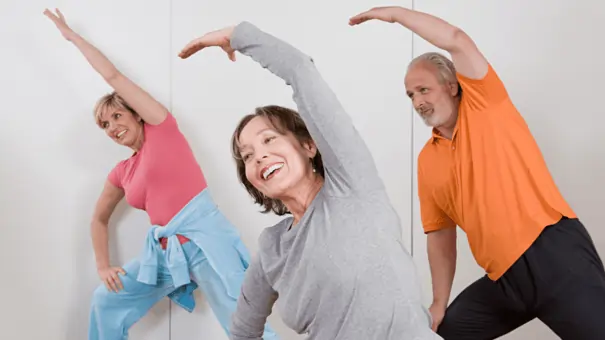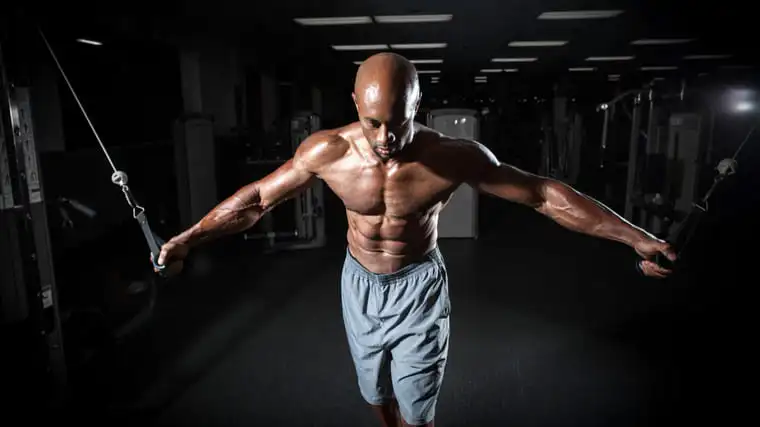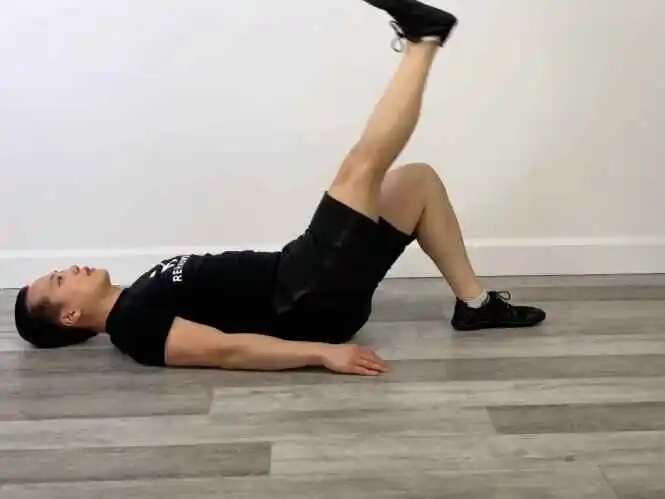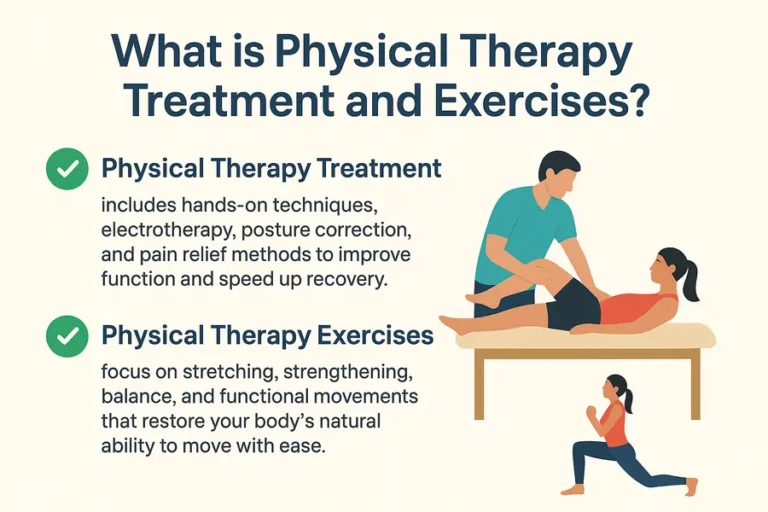20 Best Exercises for Anterior Knee Pain
Introduction:
Exercises for Anterior Knee Pain are an important component of your total treatment plan, along with pain medication, rest, and avoiding difficult tasks and exercises.
The most common complaint is knee pain in the front. Anterior knee pain is known by several names, including patellofemoral pain syndrome, runner’s knee, jumper’s knee, and patellar tendinitis. This involves jumping, squatting, getting out of a chair, and using the stairs. Swelling and a sense of instability could happen or not. Pain is often a dull ache that grows worse with incorrect exercise.
Exercises that strengthen the quadriceps muscles without putting excessive strain on the patella are necessary for the treatment and prevention of anterior knee pain. Your knee joint will be supported if you do some light stretching. Increased muscle strength reduces tension and helps your knee joint move more freely.
Before starting an exercise program for knee pain, make sure the exercises are right for you by speaking with a physician or physical therapist. They might advise certain adjustments or physical therapy that is, a regimen of supervised exercise based on your particular situation.
Causes:
A complex interaction of functional, mechanical, and structural changes and imbalances is frequently the cause of anterior knee pain, however, the exact cause is unclear.
Anterior knee pain can arise from various reasons. Most have links to the following;
- Anatomical or structural problems
- Excessive or repetitive knee usage
- Patellar fracture
- Patellofemoral instability
- Muscle weakness
- Misalignment or instability of the patella
Advantageous of exercise:
The advantages of regular exercise are listed below.
- You can regain your mobility with exercise.
- Improving coordination.
- Improve your balance.
- Release the tension in your joints.
- Improves performance with everyday workout
- Muscle strengthening and relaxation
- Reduce pain
- Make your movements better.
- Weak muscles become stronger as a result of this.
Exercises for Anterior Knee Pain:
Heel slide
- Keep your legs straight while you sleep on your back.
- Bend the knee and gently slide one heel back toward the buttock.
- Hold this position for a few seconds.
- Once your leg is straight, slowly extend your heel in the opposite direction.
- Then return to your neutral position.
- Then relax.
- Repeat this exercise five to ten times.
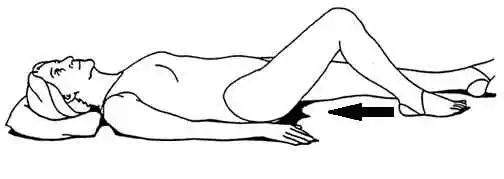
Static Quadriceps exercise
- With your back supported, either sit or lie down, and extend your legs straight out in front of you.
- Place a rolled-up towel behind your knee.
- Turn one foot slightly to the side and bring the other towards you.
- Thigh muscles should contract as a result of firmly pressing your knee down.
- Hold this position for a few seconds.
- Then return to your neutral position.
- Then relax.
- Repeat this exercise five to ten times.
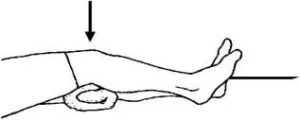
Standing quadriceps stretch
- Stand or sit close to a wall for stability.
- Your feet have to be shoulder-width apart.
- Bend one knee to bring your foot over into your glutes.
- Take hold of your ankle and comfortably pull it toward your glutes.
- Hold this position for a few seconds.
- Lower your leg.
- Then return to your neutral position.
- Then relax.
- Repeat this exercise five to ten times.
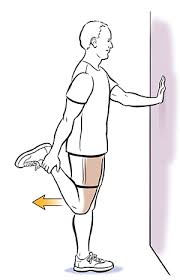
Clamshell
- You lie on your side to begin.
- Bending at the elbow, lie on your left side.
- Bend your elbow when you’re on your left side in bed.
- Then use your left hand to press into your head.
- Once your right leg and foot are positioned above your left, flex your knees to a 45-degree angle.
- For stability, place your right hand on your hip or lightly on the ground in front of you.
- Afterward, gradually lift your right knee toward the ceiling while keeping your feet close together.
- Raise your lower right leg back up to meet your left while keeping your core tight.
- Hold this position for a few seconds.
- Then return to your neutral position.
- Then relax.
- Repeat this exercise five to ten times.
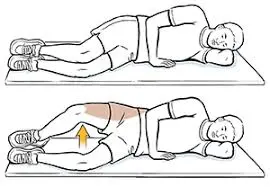
Single Leg Bridge
- Lay flat on your back in the starting posture.
- Spread your arms wide and place them by your sides.
- Bend your knees ninety degrees and raise your hips to the ceiling
- Take hold of the ground with your heels and the backs of your shoulders.
- Elevate one leg straight in the air while maintaining a high hip position.
- Hold this position for a few seconds.
- Then return to your neutral position.
- Then relax.
- Repeat this exercise five to ten times.
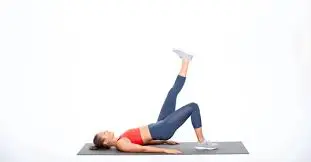
Wall sits
- Your feet should be shoulder-width apart and approximately two feet away from the wall when you are facing a wall.
- After leveling up your thighs with the floor, brace your abs and carefully lower your back down the wall.
- If your knees are directly above your ankles, place your feet so that they are over your toes instead.
- Keep your back flat and towards the wall.
- Hold this position for a few seconds.
- Once you are upright, turn around and walk back up the wall.
- Then return to your neutral position.
- Then relax.
- Repeat this exercise five to ten times.
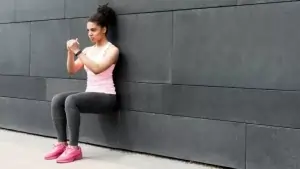
Leg presses
- Using a comfortable resistance elastic stretch band is the best approach for completing this exercise.
- Place the elastic band’s center at the arch of your foot, holding the ends in each hand.
- Bend your elbows while you’re on the ground.
- By contracting the muscles of your affected leg, you can bring your knee closer to your chest.
- Gently lift your leg in front of you while bending your foot and applying pressure to the elastic band.
- Hold this position for a few seconds.
- Then return to your neutral position.
- Then relax.
- Repeat this exercise five to ten times.
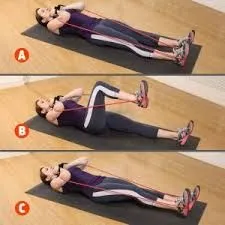
Piriformis stretch
- Start with a relaxing supine position on the ground.
- Next, bend your right leg slightly and cross your left leg over your right, as shown.
- Grab the back of the right thigh and pull it in toward the chest once the leg is fully straight up and unable to rise any further.
- Hold this position for a few seconds.
- Then return to your neutral position.
- Then relax.
- Repeat this exercise five to ten times.
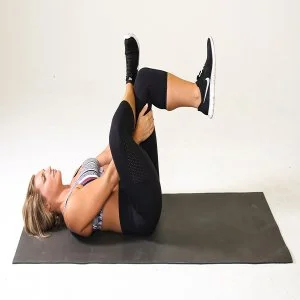
Bridge
- Lying flat on your back, bend both knees and place both feet flat on the floor.
- Arms should be kept by your sides, palms down.
- If support for the head and neck is required, put a small pillow underneath.
- As you gradually raise your pelvis, raise your back.
- Hold this position for a few seconds.
- Beginning at the top of the spine, slowly drop the pelvis and return toward the ground.
- Lower into the spine until the entire back is flat against the floor again.
- Then return to your neutral position.
- Then relax.
- Repeat this exercise five to ten times.
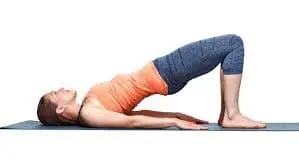
Lying hamstring stretch
- Begin in a comfortable lying down position on the ground.
- Now bend just one knee.
- Place your hands behind your leg and just behind your knee.
- Elevate one leg over the ground and bring it up to your chest.
- If you find it difficult to get your hands behind your leg, you can loop the band over your thigh instead.
- Bring your leg in towards you while holding it with your band.
- Hold this position for a few seconds.
- Then release your leg.
- Then return to your neutral position.
- Then relax.
- Repeat this exercise five to ten times.
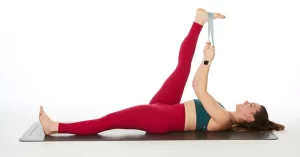
Step-ups
- Begin in a comfortable standing position.
- Place one on a platform, the bottom step of a stairwell, or the foot of a step bench.
- Keep your height at the level of your pelvis.
- With your knee bent, slowly lower your opposing foot to the ground.
- Step back up to take your place after putting your toe on the ground gently.
- Then return to your neutral position.
- Then relax.
- Repeat this exercise five to ten times.

Straight-Leg Piriformis Stretch
- First, lie on your back.
- Lift and cross your left leg over your chest while making an effort to touch the ground with your right hand.
- Hold this position for a few seconds.
- Then release your leg.
- Then return to your neutral position.
- Then relax.
- Repeat this exercise five to ten times.
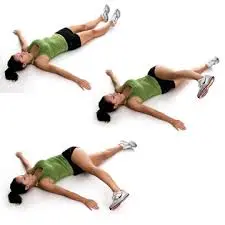
Half-kneeling hip flexor stretch
- Your right knee should be on the floor behind you as you kneel on the floor, your left foot flat in front of you.
- You can keep your hands by your sides or rest them on the front knee for support if necessary.
- keeping the upper body straight.
- Proceed to bend forward until you experience a stretch.
- Hold this position for a few seconds.
- Then return to your neutral position.
- Then relax.
- Repeat this exercise five to ten times.
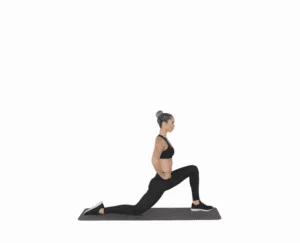
Leg extensions
- Sit up straight in a long chair and place your leg on the floor or a plinth to start.
- Tighten your thigh muscles, face forward, and raise one leg as high as you can to build strength without getting off the chair.
- Hold this position for a few seconds.
- Then return to your neutral position.
- Then relax.
- Repeat this exercise five to ten times.
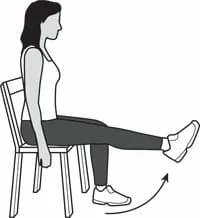
Double Knee To Chest
- Laying flat on your back, spread your legs wide apart.
- Place your hands on the top of the leg, just below the knee, and raise both knees to the same level.
- The backs of your thighs are an additional location to place your hands.
- Lift your legs slowly to your chest.
- Hold this position for a few seconds.
- Then return to your neutral position.
- Then relax.
- Repeat this exercise five to ten times.
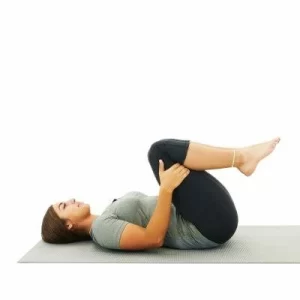
Straight leg raises
- Lie down on the floor or a table in a comfortable position to start.
- Bend your knees slightly now.
- Next, gradually elevate your one leg.
- On the other side, maintaining a straight knee.
- Hold this position for a few seconds.
- Then lower your leg.
- Then return to your neutral position.
- Then relax.
- Repeat this exercise five to ten times.
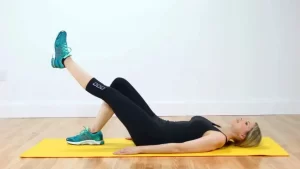
Hamstring curl
- Get comfortable standing up right away.
- Your feet ought to be separated by a hip’s depth.
- Should you want support, grab a chair or something stable.
- Stretch one knee and lift one heel toward the sky while you elevate one foot.
- Maintaining a straight upper body and forward-pointing legs, stretch as far as you can.
- Hold this position for a few seconds.
- Then return to your neutral position.
- Then relax.
- Repeat this exercise five to ten times.
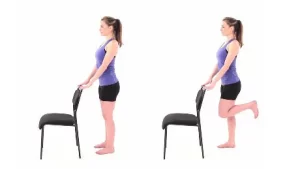
Side-Lying Quadricep Stretch
- Start by locating a spot on the ground where you can comfortably rest your side.
- Gently pull with your hand to bend the knee of your upper leg as far as possible.
- Hold this position for a few seconds.
- Release your leg.
- Then return to your neutral position.
- Then relax.
- Repeat this exercise five to ten times.
- After switching legs, do the exercise again.
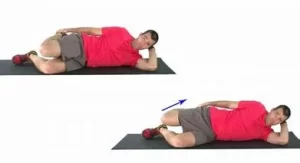
Single knee to chest
- To start, lie down on your back on a comfortable surface, such as a yoga mat, or bed.
- Maintain a relaxed posture while holding this stretch.
- Slide your left knee slightly in the direction of your chest with both hands beneath it.
- Hold this position for a few seconds.
- Then return to your neutral position.
- Then relax.
- Repeat this exercise five to ten times.
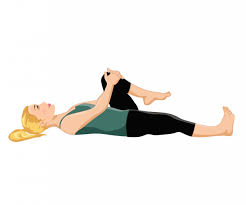
Calf raises
- Place your feet shoulder-width apart as you stand.
- Grab the back of a chair or get near to a wall for support.
- To stand on the heel of your feet, lift both of your heels off the ground.
- Hold this position for a few seconds.
- Reduce the heel to the floor gradually.
- Then return to your neutral position.
- Then relax.
- Repeat this exercise five to ten times.
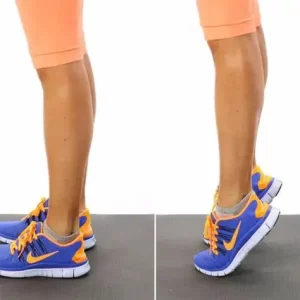
When working out, what safety measures should I take?
- Make sure the equipment you use fits you properly.
- When exercising, take care of yourself and be alert to prevent falls.
- To properly perform the exercise, extend, hold, and repeat.
- Wear loose clothing when working out so that your body can move freely.
- If the stiff muscles seem hard to stretch, that’s okay, but you shouldn’t ever feel sharp or severe pain.
- Make sure you exercise with a straight posture.
- After each workout, give yourself a little rest.
- Never hold your breath when exercising. When exercising, take a deep breath and release it slowly. Because it tightens your muscles, deep breathing causes blood pressure to rise.
When do you stop exercising?
- Fever
- Severe pain in the muscles
- Headache
- If your doctor advised you to take a few days off from exercise.
- If, during exercise, you suddenly develop knee pain, get medical help.
Which exercises or activities should you refrain from if you have anterior knee pain?
- Work out until you feel the smallest amount of pain, but don’t push past it.
- Stay out of repetitive tasks until the pain goes away.
- Avoiding kneeling and high squatting is advised.
- Do not stand with your knees locked for prolonged periods.
Summary:
The phrase “anterior knee pain” refers to pain that is generally felt in the front of the knee.
The patella tendon, which connects your thigh muscles to the bone right below the knee cap, and the patellofemoral joint, which is located between your knee cap and thigh bone, are the most frequently painful structures in this region.
By performing stretching and strengthening exercises that target the muscles that support your knees, you may be able to reduce pain, improve your range of motion and flexibility, and reduce the likelihood of suffering another injury.
It is important to consult a physician or physical therapist before beginning an exercise regimen if you have joint pain. Based on the cause of your pain and its associated factors, they can also suggest exercises and alterations.
A person can manage anterior painful knees by making lifestyle adjustments such as keeping a healthy weight, selecting shoes that fit properly, and avoiding activities that make the pain worse.
FAQ:
Is exercise beneficial for treating anterior knee pain?
Exercise is a common strategy for pain management and preventing further injury and suffering. One kind of exercise that helps the body’s supporting muscles get stronger is stretching. Regular exercise can help to reduce the frequency of reoccurring pain.
What is the treatment for anterior knee pain?
Anterior knee pain can usually be relieved and the young athlete can resume playing their favorite sports with the use of straightforward interventions like rest, over-the-counter medicines, and strengthening exercises.
Which muscles need to be strengthened if I have anterior knee pain?
For people with patellofemoral pain, exercises targeting the muscles of the thigh (quadriceps) and hip (abductors, lateral rotators, and extensors) are helpful. Based on available data, it is recommended to perform these exercises three times a week for a minimum of six weeks.
Does walking help with knee pain?
Walking is an excellent kind of exercise, particularly for older adults, as it lowers joint tension and improves circulation, balance, and heart health.
Which people are most susceptible to anterior knee pain?
It is more prevalent for anterior knee pain in those who are overweight. individuals whose kneecaps have been fractured, dislocated, or otherwise injured. Skiers, jumpers, joggers, cyclists, and soccer players who practice frequently.
Can someone who has anterior knee pain run?
Avoid running when you’re hurting and wait to resume until you’ve healed enough.
Where does anyone experience pain in the anterior knee?
Anterior knee pain can present with any of these symptoms. steps, kneeling, squatting, lunging, jumping, and sprinting can all cause more pain in the front of the knee. Leg flexion is difficult to do entirely.
Does stair climbing help with knee pain?
Stair climbing may worsen or improve your knee health, so it can be helpful to have a physiotherapist conduct a comprehensive evaluation, determine your needs, and create a customized program to help you achieve greater knee functionality and comfort.
How frequently should someone who is experiencing anterior knee pain exercise?
Every day, you should spend at least 20 to 30 minutes performing exercises for anterior knee pain.
A regular stretching and exercise regimen will help you.
Which exercises should you stay away from if you have pain in your anterior knee?
Exercises with a lot of impact could worsen knee pain.
Stay away from knee-stressing exercises like deep squats and lunges that cause forceful movements. If not used properly, these could result in tragic results as well as additional pain. It can cause harm if done incorrectly. Exercises like kickboxing, running, and leaping are examples.
References:
- December 13, 2023c, Bariya, D. The Top 25 Exercises for Anterior Knee Pain (Mobile Physio). Mobile Clinic for Physiotherapy. The top 25 exercises to relieve anterior knee pain are as follows: The website https://mobilephysiotherapyclinic.in/
- R. A. Tee-Melegrito (2023, February 14). Know this about anterior knee pain. Medical News Today’s post “Anterior Knee Pain”
- ANKLE PAIN IN YOUR PHYSIO (n.d.). Anterior knee pain is one of the conditions listed under “Knee Conditions” on https://www.yourphysio.org.uk.
- 2024, January 31; Lindberg, S. Ten Exercises to Reduce Knee Pain. We line. Exercises for Knee Pain: https://www.healthline.com/health/
- Program for Knee Conditioning – OrthoInfo – AAOS (n.d.). The knee conditioning program is available at https://orthoinfo.aaos.org/en/recovery/
- Image 12, Exercises for the Knee | Lakelands Orthopedics, n.d. hip exercises https://lakelandsorthopaedics.com/ortho-education.html



